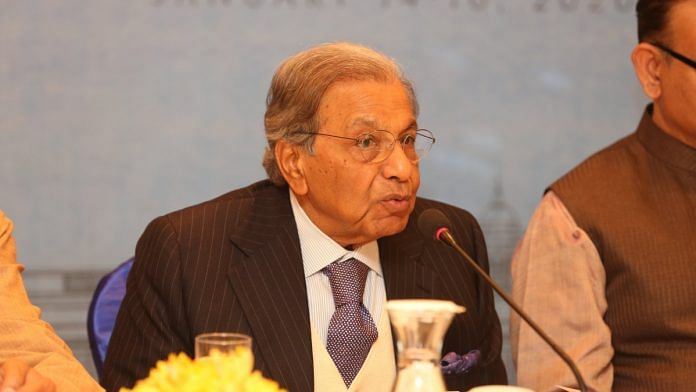New Delhi: The conditions placed by the central government on additional borrowings will improve medium-term growth potential of states, and ensure that they are able to service their debt, according to N.K. Singh, chairman of the 15th Finance Commission.
Singh’s comments come at a time when many states, including West Bengal, Tamil Nadu, Telangana and Kerala, have opposed the Centre’s move to attach conditions while increasing the borrowing limit for states to 5 per cent of their gross state domestic product from the earlier 3 per cent.
Singh was briefing the press after the meeting of the committee set up by the 15th Finance Commission to make recommendations for the fiscal consolidation roadmap for the Centre and the states for 2021-22 to 2025-26.
Besides members of the 15th Finance Commission, the meeting was attended by Chief Economic Advisor Krishnamurthy Subramanian, representatives of some states, and economists Sajjid Z. Chinoy and Prachi Mishra.
Also read: Narendra Modi govt has failed India in its hour of need — both economy and people
Debt sustainability
Singh welcomed the government’s decision to allow states to borrow more, and pointed out that the conditions placed on the higher borrowing limit will be crucial in ensuring ‘debt sustainability’.
“States also need to have a sustainable debt path and need to find resources to repay the debt that they borrow. All these reforms are completely consistent with the discussions in the Finance Commission, and will improve medium-term growth potential of states,” he said, adding that many states have already taken steps towards implementing some of these reforms.
“No borrowing is an automatic right,” Singh pointed out.
The central government allowed states to borrow up to 3.5 per cent of the GSDP unconditionally, but placed conditions for borrowing over this limit.
These included steps like seeding of Aadhaar with ration cards, increasing property tax rates and levying user charges on water, and bringing in reforms to make state-owned power distribution firms more profitable, including providing free power to farmers only through the direct benefit transfer route.
Don’t cut expenditure drastically
Singh also favoured that the Centre and the states should not cut expenditures drastically this year, and capital outlays should remain elevated.
Singh said the Finance Commission will wait for the growth numbers of the fourth quarter of 2019-20 and the first quarter of 2020-21 before deciding on the nominal GDP numbers on which to base its calculations.
So far, the real GDP growth estimates (nominal GDP growth minus inflation) for India have varied between -5 per cent to 1 per cent.
The 15th Finance Commission will decide what percentage of the total pool of central taxes will be shared with the states for the five years beginning 2021-22.
Awaiting clarity
Singh said that the fiscal committee will meet again and awaits clarity on many macroeconomic variables.
The commission will have to decide on the fiscal consolidation roadmap at a time both the central government and the state governments are facing a sharp contraction in revenues, accompanied by an increase in expenditure due to the Covid-19 pandemic and the resultant lockdown, which has brought most economic activities to a near-halt.
According to the existing fiscal consolidation roadmap, India’s fiscal deficit had to touch 3 per cent of gross domestic product by 2020-21. However, Finance Minister Nirmala Sitharaman chose to invoke an escape clause of 0.5 percentage points in her 1 February Budget speech, thereby increasing the fiscal deficit target to 3.5 per cent of GDP.
But with the pandemic, India is unlikely to meet this revised target too.
Singh said that the government’s decision to increase its borrowing programme by 50 per cent to Rs 12 lakh crore will not need an amendment to the Fiscal Responsibility and Budget Management Act.
Also read: Covid-19 has hit govt funds, but printing more money not good idea, says finance panel chair






